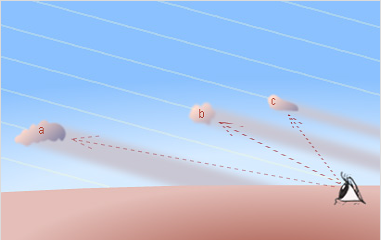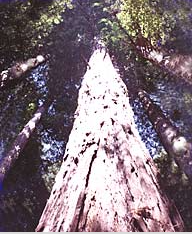Ray formation
Ray Formation: A Closer Look at the Play of Light and Shadows
When we gaze at the sky and observe rays of sunlight streaming through clouds, it may appear as though they are radiating away from the sun, creating a beautiful spectacle. However, let's take a moment to truly understand the phenomenon of ray formation. Instead of perceiving them as ethereal beams of light, envision long parallel columns of both light and darkness streaming downwards towards you, gradually widening as they draw closer.
The captivating display of sunrays requires the presence of clouds to cast shadows and divide the sky into contrasting columns of shaded and sunlit air. These rays, originating from the sun and reaching our planet, are all parallel, just like the shadowed regions created by the clouds. In reality, they are tangible entities - immense columnar columns that are bereft of sunlight and filled with darkness.
Although shadows and rays typically slant downwards when the sun is still above the horizon, there are instances when they seem to shoot upwards from the clouds. This peculiar effect is purely a matter of perspective. Shadow volumes, which are three-dimensional objects, always appear in perspective. For instance, if we consider the shadow cast by cloud "a," it reaches the ground between the sun and the observer's eye. As a result, the shadow is perceived below the cloud. The section of the shadow closest to the ground appears wider due to its proximity. On the other hand, shadows from clouds "b" and "c" slant downwards at the same angle but reach the ground past the observer's eye. Consequently, they seem to radiate upwards from the cloud and would continue overhead if they were still visible.
The captivating interplay of rays and shadows extends beyond our skies. Even in the natural world, similar perspective effects can be observed. Consider a redwood grove where the trees, with their columnar and parallel forms, exhibit these same perspective phenomena. While the trees are solid wood rather than shadowy air, they showcase the intriguing effects of perspective that we often witness in the sky.
The visibility of rays and shadows is most pronounced near the sun, where shadows appear darkest because the observer is looking along their length. In other areas, the path lengths across the shadows are significantly shorter, leading to less pronounced contrasts. Additionally, larger dust particles in the atmosphere scatter sunlight forward, causing the air to shine brighter near the sun.
When the observer's gaze is directed opposite to the sun, where the eye looks along the shadows, they darken once again, creating a striking contrast with the sunlit sky. These converging rays, heading towards the antisolar point, are referred to as anti-crepuscular rays.
Although the sun is approximately 93 million miles away, its substantial size makes its globe appear 0.5º across. Consequently, rays spread up to 0.25º on each side of their mean direction. This slight dispersion causes the "umbral" or completely unlit parts of cloud shadows to narrow slightly as they move away from the cloud.
In conclusion, understanding ray formation allows us to appreciate the mesmerizing beauty of the sky even more deeply. By visualizing rays as elongated columns of sparkling sunlit air interspersed with adjacent unlit voids, we can transcend our usual perception of the sky's flatness and immerse ourselves in its dynamic and captivating nature. The interplay of light and shadows continues to fascinate us, both above and within our earthly surroundings, reminding us of the intricate dance between illumination and darkness that shapes our visual experiences.

Rays and shadows as seen by the eyes.
They appear to radiate away from the sun as though it were nearby, close to the clouds.
Instead of perceptions, let the mind picture them truthfully - long parallel columns of light and darkness streaming downwards towards you. As they get closer they appear wider and wider.

Sunrays need clouds to shadow the sun and divide the sky into contrasting columns of shaded and sunlit air.
The sun's rays reaching planet Earth are all parallel and the cloud shadowed regions are parallel too. They are tangible things, immense columnar columns, dark, bereft of sunlight.
When the sun is still above the horizon the shadows and rays must always slant downwards but sometimes they appear instead to shoot upwards from clouds. This is purely a perspective effect.
Shadow volumes are real three dimensional objects and they are always seen in perspective. Take the shadow from cloud "a". It reaches the gorund between the sun and the eye. The shadow is seen below the cloud. The shadow nearest the ground is closer and so appears wider. In contrast, shadows from clouds "b" and "c" slant downwards at exactly the same angle but reach the ground past eye. to the eye they appear to radiate upwards from the cloud and would, if they were still visible, pass high overhead.

The trees in this redwood grove are roughly columnar and parallel. Though solid wood rather than shadowy air, they show the same perspective effects.
Next time you see sunrays, imagine them for what they really are, miles long columns of sparkling sunlit air highlighted by the darkness of adjacent unlit voids. Let the mind fly around and through them to give them solid form that replaces the flattish way we normally see the sky.
Rays and shadows are most visible near to the sun. There the shadows are darkest because the eye is looking along their length. Elsewhere the path lengths across the shadows are much shorter. There is a second reason, larger dust particles scatter sunlight sharply forward and so the air shines brighter near the sun.
Another direction where the eye looks along the shadows is in the opposite direction to the sun. There the shadows again darken and the contrast with the sunlit sky increases. Rays converging towards the antisolar point are called anti-crepuscular.
. The shadows are not quite parallel because, although the sun is ~93 million miles away, it is so large that its globe appears 0.5º across. Rays consequently spread up to 0.25º each side of the mean direction. This causes the 'umbral' or absolutely unlit parts of cloud shadows to narrow slightly with increasing distance from the cloud.
Note: this article has been automatically converted from the old site and may not appear as intended. You can find the original article here.
Reference Atmospheric Optics
If you use any of the definitions, information, or data presented on Atmospheric Optics, please copy the link or reference below to properly credit us as the reference source. Thank you!
-
<a href="https://atoptics.co.uk/blog/ray-formation/">Ray formation</a>
-
"Ray formation". Atmospheric Optics. Accessed on December 21, 2024. https://atoptics.co.uk/blog/ray-formation/.
-
"Ray formation". Atmospheric Optics, https://atoptics.co.uk/blog/ray-formation/. Accessed 21 December, 2024
-
Ray formation. Atmospheric Optics. Retrieved from https://atoptics.co.uk/blog/ray-formation/.